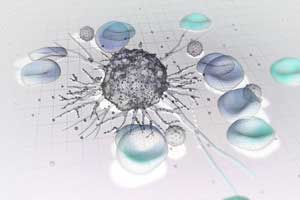| Aug 30, 2018 | |
Charged polymer nanoballs attack tumors directly, without drugs(Nanowerk News) A new approach to fighting cancer using large, electrically charged molecules to physically disrupt tumor cells has been demonstrated by A*STAR researchers (Journal of the American Chemical Society, "Addressing drug resistance in cancer with macromolecular chemotherapeutic agents"). Tumors cannot develop resistance to the treatment and it prevents cancer from spreading. |
|
| Doctors have a vast array of drugs at their disposal for attacking tumors. But while these drugs can often be very effective initially, tumors frequently become resistant to them, causing the cancer to bounce back. Furthermore, cancer cells can migrate to other organs and seed the formation of secondary tumors. | |
| These problems are being increasingly untenable. “More and more anticancer drugs are being given to each patient to overcome drug resistance and prevent the spread of cancer,” says Yi Yan Yang of the A*STAR Institute of Bioengineering and Nanotechnology. Yang and her co-workers have devised a method that overcomes both problems. | |
 |
|
| Cancer can spread in the body through cancer stem cells traveling in the bloodstream (schematically depicted in image). Micelles developed by A*STAR researchers can physically attack both cancer cells and cancer stem cells, thereby destroying the original tumor and preventing the spread of cancer. (Image: MedicalRF.com/Getty) | |
| They used micelles — nanoscale balls made up of long polymer molecules. Micelles are often used to encapsulate anticancer drugs and ferry them to tumors, where they release their payload. But the micelles developed by Yang’s team do not transport drugs; rather they are themselves the weapon that physically destroys the tumor. | |
| The polymers have one positively charged end. These ends, which form the cores of the micelles, attach to the negatively charged membranes of cancer cells and physically disrupt them. As the outer membrane surfaces of healthy cells are electrically neutral, the micelles do not affect them. In addition, since the blood vessels near tumor tissues are leaky, the micelles preferentially accumulate at tumors, and hence target tumor tissues. | |
| The researchers demonstrated the effectiveness of their method by using the micelles to destroy human liver cancer cells in mice. | |
| Because this is a physical mechanism, tumor cells cannot develop resistance to it. Furthermore, it is effective against cancer stem cells, which are widely believed to be the cells responsible for spreading cancer to other parts of the body. | |
| An additional advantage is the speed at which the micelles attacked cancer cells. “The anticancer drug doxorubicin takes several hours to kill cancer cells,” says Yang. “Our micelles are much faster; they killed cancer cells within 30 minutes.” | |
| The micelles could be combined with other treatments. “In the future, we will investigate using the micelles with small-molecule anticancer drugs,” says Yang. “We may be able to reverse drug resistance.” |
| Source: A*STAR | |
|
Subscribe to a free copy of one of our daily Nanowerk Newsletter Email Digests with a compilation of all of the day's news. |
